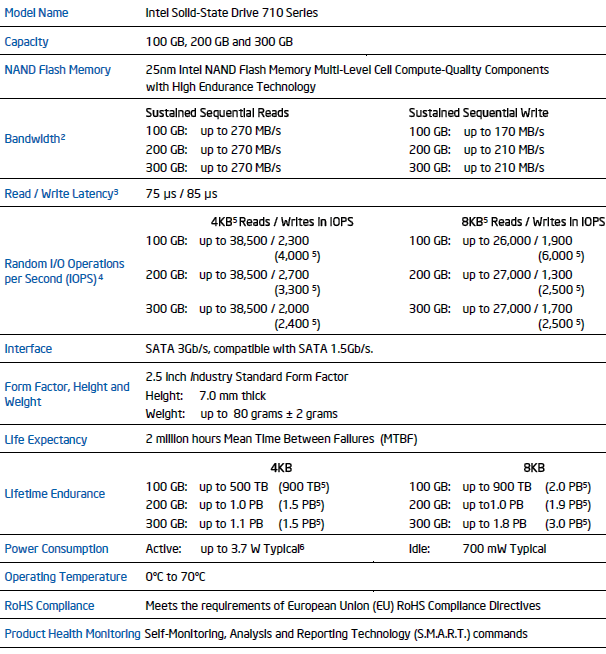Introduction and Specifications
Intel’s X25-M (mainstream) and X25-E (enterprise) solid state drives proved to be very popular in their respective target markets. As our testing showed back in the day, these drives offer excellent performance, and as time in the field would tell, they were quite reliable as well.
On the desktop / mainstream front, Intel has since launched a number of popular new solid state drives based on a few different controller designs, including those from SandForce, Marvell, and Intel themselves. Things are much slower moving on the enterprise front, however, where stability and reliability are paramount. The X25-E remained Intel’s flagship enterprise-class SSD for a couple of years, which is an eternity in technology-time. A few months back though, Intel launched a new enterprise-class SSD that was designed to offer the reliability and performance of the X25-E, but at higher capacities and a lower cost per GB. That solid state drive is the Intel SSD 710, of which we’ll be showing you here today.
There are a number of differences between the Intel X25-E and SSD 710 series which we’ll cover a bit later, but the biggest change is the move from SLC NAND to compute-quality (to use a term coined by Intel) MLC NAND flash. The move to MLC NAND significantly lowers costs, but in traditional solid state drives, MLC NAND isn’t nearly as durable. Intel has a few tricks up its virtual sleeve to address the issue of durability with the SSD 710 series, however.
|

Although there isn’t a hard and fast rule that’ll determine the longevity and reliability of an average SSD, their typical write endurance ranges from a handful to a few dozen terabytes on a 100 – 300GB drive. With Intel’s enterprise-class solid state drives like the X25-E and SSD 710 series, that write endurance number jumped into the few hundred terabytes to 1-2 petabyte range, which is a fancy way to say these enterprise class drives can handle many, many more write-cycles than a typical SSD.
Intel SSD 710 Series Enterprise-Class Solid State Drive
According to Intel, the out-of-the-box write endurance for the 200GB SSD 710 series drive we’ll be showing you here is up to 1.0 petabyte. This number can be changed by overprovisioning and based on workload, however. If the Intel SSD 710 series drive is overprovisioned by 20 percent, for example, it can achieve 1.5 PB write endurance on 4K writes and up to 3 PB on 8K writes.
If you take a look inside the Intel SSD 710 series drive, you’ll see it strongly resembles the mainstream SSD 320 series drive we showed you here, as the two feature the same Intel controller design. With the SD 710 series though, Intel has modified the firmware for enterprise-class workloads and paired the controller to higher-quality NAND.
The flash memory used in the SSD 710 series is Intel “compute-quality” 25nm Multi-Level Cell (MLC) SSD NAND with High Endurance Technology, or HET. If you’re unfamiliar with the term HET, Intel HET combines NAND silicon enhancements and management techniques to extend the write endurance of MLC-based solid state drives. Intel HET is essentially a term used to describe the combination of Intel-developed firmware, the Intel controller, and high-cycling NAND that’s optimized for endurance. Firmware enhancements from Intel include optimized error avoidance techniques; write amplification reduction algorithms, and system-level error management beyond the normal industry Error Correction Code (ECC) standards.
In addition to high-endurance, the Intel SSD 710 also offers security related features, i.e. built-in encryption capabilities, power-loss protection, and surplus arrays of NAND, for further long-term reliability.
One of the drawbacks to using Intel’s own controller is that the SSD 710 series drive doesn’t have a SATA III interface and won’t offer performance that’s much better than the X25-E. The 710 Series offers writes of up to 210 MB/s, with random 4K writes up to 2,700 Input / Output Operations Per Second (IOPS). The drive also offers sequential reads of up to 270 MB/s and random 4K reads up to 38,500 IOPS.






